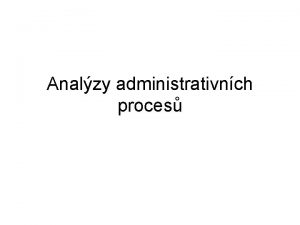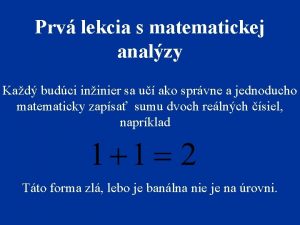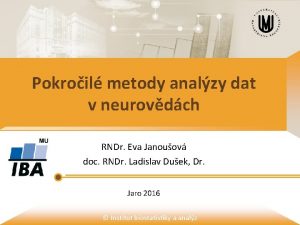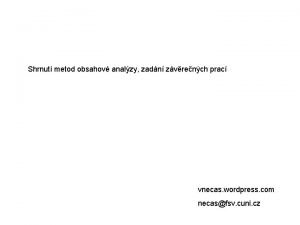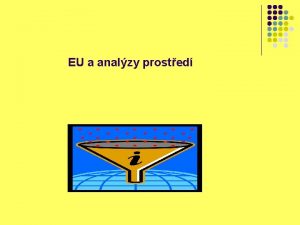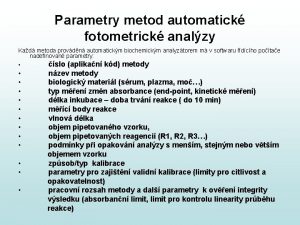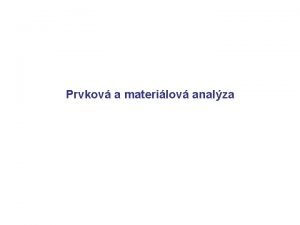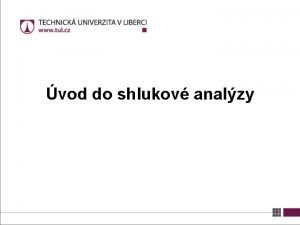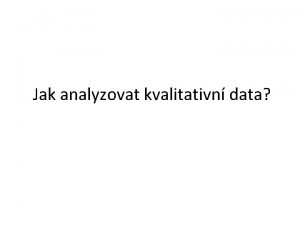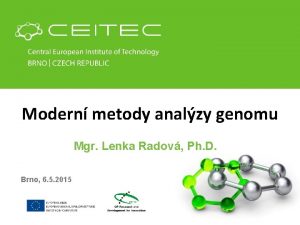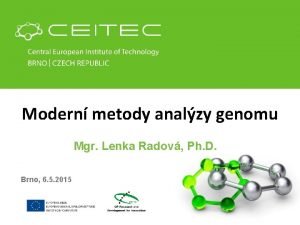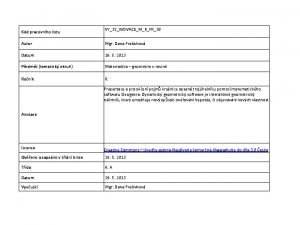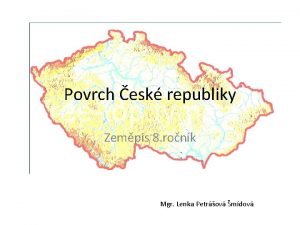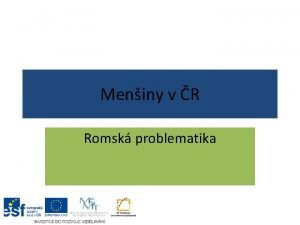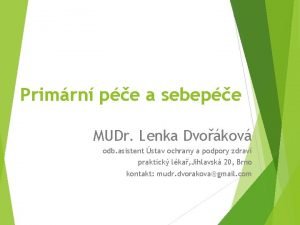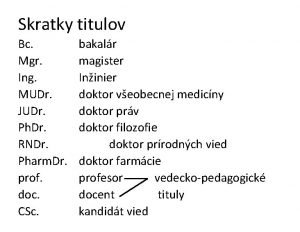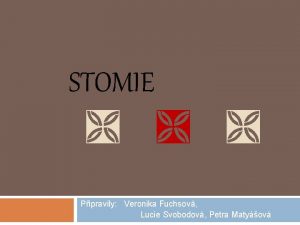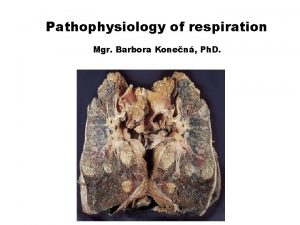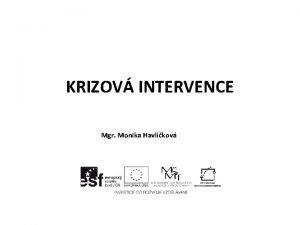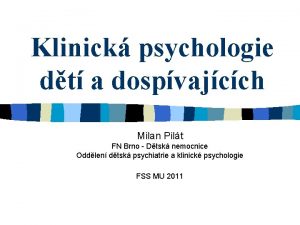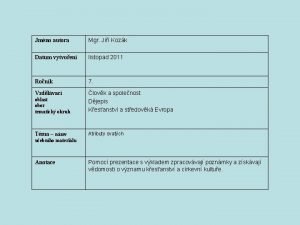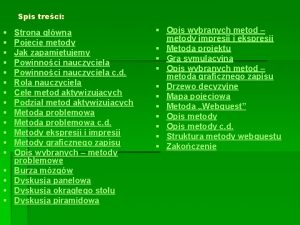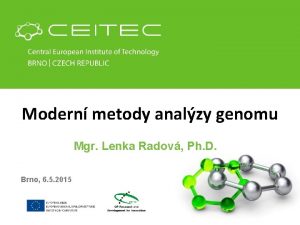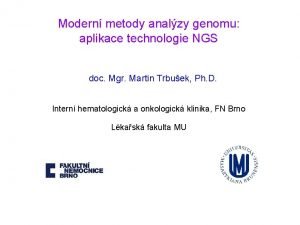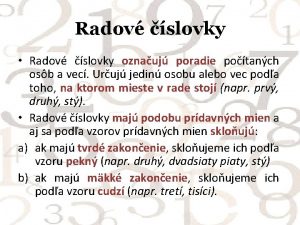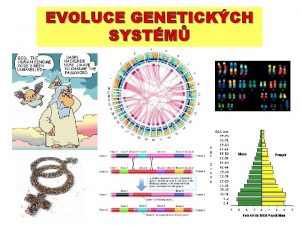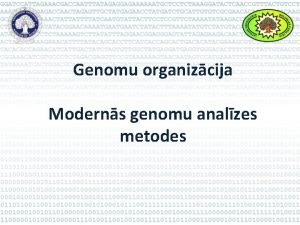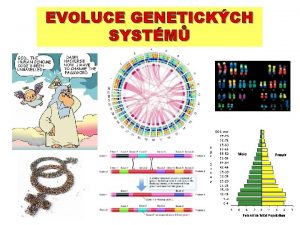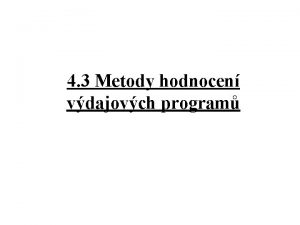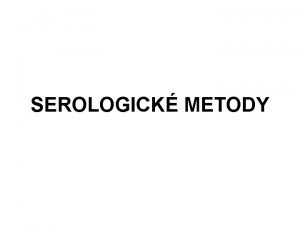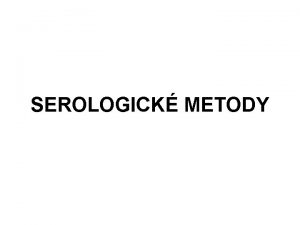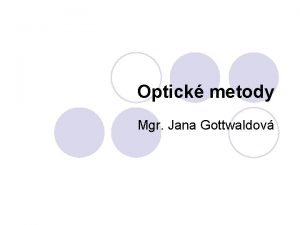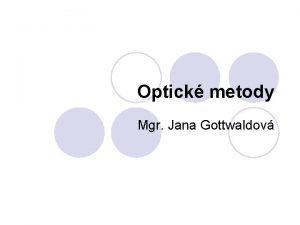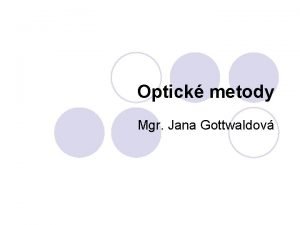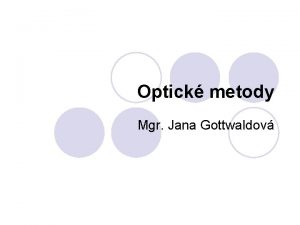Modern metody analzy genomu Mgr Lenka Radov Ph











































- Slides: 43

Moderní metody analýzy genomu Mgr. Lenka Radová, Ph. D. Brno, 6. 5. 2015

Brief workflow • RNA is isolated from cells, fragmented at random positions, and copied into complementary DNA (c. DNA). • Fragments meeting a certain size specification (e. g. , 200– 300 bases long) are retained for amplification using PCR. • After amplification, the c. DNA is sequenced using NGS; the resulting reads are aligned to a reference genome, and the number of sequencing reads mapped to each gene in the reference is tabulated. • These gene counts, or digital gene expression (DGE) measures, can be transformed and used to test differential expression

But… many steps in experimental process may introduce errors and biases

Scales of genome size

QC in Galaxy

FASTQ format • The first line starts with '@', followed by the label • The third line starts with '+'. In some variants, the '+' line contains a second copy of the label • The fourth line contains the Q scores represented as ASCII characters

Q scores of FASTQ

Quality control tools for NGS data • fast. QC in Galaxy • QC report in CLCbio

From microarrays to NGS data • As research transitions from microarrays to sequencing-based approaches, it is essential that we revisit many of the same concerns that the statistical community had at the beginning of the microarray era • series of articles was published elucidating the need for proper experimental design

Basic biological problems • Identification of mutations - somatic - germinal • Expression analyses - genes, mi. RNAs, etc. An Introduction to Genetic Analysis. 7 th edition. Griffiths AJF, Miller JH, Suzuki DT, et al. New York: W. H. Freeman; 2000

Mutation identification • Whole exome or whole genome data, ultra-deep sequencing • Output: VCF-format

Mutation identification • Aim: identification of point mutations • Application: diagnostic of diseases - inherited (germinal, de-novo mutations) e. g. familiar hypercholesterolemia, hemophylia, cystic fibrosis… - gained (somatic mutations) e. g. cancer, leukemia, …

Germinal mutations • • Comparison with reference genome Expected allele frequency: 30 -100% Softwares: GATK, Var. Scan, … Usage: e. g. prenatal diagnostic

Somatic mutations • Comparison tumor-normal (matched, unmatched) • Expected allele frequency: >0, 2% • Softwares: Mu. Tect, Free. Bayes, deep. SNV, … • Usage: translational research, cancer diagnostic, personalized medicine, …

Expression analyses – RNA-seq • characterization of gene expression in cells via measurement of m. RNA levels • Output: expression level table

RNA-seq • Aim: identification of genes differentially expressed in tissues with different conditions (tumor vs normal, treated vs untreated, different stages of illness, …) • Application: translational research, diagnostic of diseases

Expression level in RNA-seq = The number of reads (counts) mapping to the biological feature of interest (gene, transcript, exon, etc. ) is considered to be linearly related to the abundance of the target feature

What is differential expression? • A gene is declared differentially expressed if an observed difference or change in read counts between two experimental conditions is statistically significant, i. e. whether it is greater than what would be expected just due to natural random variation. • Statistical tools are needed to make such a decision by studying counts probability distributions.

Definitions • Sequencing depth: Total number of reads mapped to the genome. Library size. • Gene length: Number of bases. • Gene counts: Number of reads mapping to that gene (expression measurement)

Experimental design • Pairwise comparisons: Only two experimental conditions or groups are compared. • Multiple comparisons: More than 2 conditions or groups. Replicates • Biological replicates. To draw general conclusions: from samples to population. • Technical replicates. Conclusions are only valid for compared samples.

RNA-seq biases • Influence of sequencing depth: The higher sequencing depth, the higher counts. • Dependence on gene length: Counts are proportional to the transcript length times the m. RNA expression level. • Differences on the counts distribution among samples.

Options 1. Normalization: Counts should be previously corrected in order to minimize these biases. 2. Statistical model should take them into account.

Normalization methods • RPKM (Mortazavi et al. , 2008) = Reads per kilo base per million: Counts are divided by the transcript length (kb) times the total number of millions of mapped reads • Upper-quartile (Bullard et al. , 2010): Counts are divided by upperquartile of counts for transcripts with at least one read. • TMM (Robinson and Oshlack, 2010): Trimmed Mean of M values. • Quantiles, as in microarray normalization (Irizarry et al. , 2003). • FPKM (Trapnell et al. , 2010): Instead of counts, Cufflinks software generates FPKM values (Fragments Per Kilobase of exon per Million fragments mapped) to estimate gene expression, which are analogous to RPKM.

Differential expression • Parametric assumptions: Are they fulfilled? • Need of replicates. • Problems to detect differential expression in genes with low counts.

Goal • Based on a count table, we want to detect differentially expressed genes between conditions of interest. • We will assign to each gene a p-value (0 -1), which shows us 'how surprised we should be' to see this difference, when we assume there is no difference.

Goal

Algorithms under active development http: //wiki. bits. vib. be/index. php/RNAseq_toolbox#Detecting_differential_expression_by_count_analysis

Intuition - gene sample 1 sample 2 sample 3 sample 4 sample 5 sample 6 sample 7 sample 8 23171 22903 29227 24072 23151 26336 25252 24122 Sample 9 sample 10 sample 11 sample 12 sample 13 sample 14 sample 15 sample 16 Condition B 19527 26898 18880 24237 26640 22315 20952 25629 Condition A Variability B } Compare and conclude given a Mean level: similar or not?

Intuition Difference is quantified and used for p-value computation

Dispersion estimation • For every gene, a NB is fitted based on the counts. The most important factor in that model to be estimated is the dispersion. • DESeq 2 estimates dispersion by 3 steps: 1. Estimates dispersion parameter for each gene 2. Plots and fits a curve 3. Adjusts the dispersion parameter towards the curve ('shrinking')

Dispersion estimation • Black dots = estimates from the data • Red line = curve fitted • Blue dots = final assigned dispersion parameter for that gene Model is fitted

Test runs between 2 conditions • for each gene 2 NB models (one for each condition) are made, and a Wald test decides whether the difference is significant (red in plot).

Test runs between 2 conditions • for each gene 2 NB models (one for each condition) are made, and a Wald test decides whether the difference is significant (red in plot). i. e. we are going to perform thousands of tests… (if we set a cut-off on the p-value of 0, 05 and we have performed 20000 tests, 1000 genes will appear significant by chance)

Check the distribution of p-values • If the histogram of the p -values does not match a profile as shown here, the test is not reliable. Perhaps the NB fitting step did not succeed, or confounding variables are present.

Improve test results Correctly identified as DE False positive fraction 0. 05 Cut-off

Improve test results • Avoid testing = apply a filter before testing, an independent filtering • Apply multiple testing correction

Multiple testing corrections • Bonferroni or Benjamini-Hochberg correction, to control false discovery rate (FDR). • FDR is the fraction of false positives in the genes that are classified as DE. • If we set a threshold α of 0, 05, 20% of the DE genes will be false positives.

Why to apply multiple testing correction? Consider a case where you have 20 hypotheses to test, and a significance level of 0. 05. ? ? ? What's the probability of observing at least one significant result just due to chance? ? ? P(at least one significant result) = 1 - P(no signif. results) = 1 - (1 – 0. 05)20 ≈ 0. 64 So, with 20 tests being considered, we have a 64% chance of observing at least one significant result, even if all of the tests are actually not significant.

Including different factors Treatment G Treatment AG Day 1 Day 2 WT Mutant (UPC) Additional metadata (batch factor)

Including different factors Treatment G Treatment AG Day 1 Day 2 WT Mutant (UPC) Additional metadata (batch factor) Which genes are DE between UPC and WT? Which genes are DE between G and AG? Which genes are DE in WT between G and AG?

Statistical model Gene = strain + treatment + day • export results for unique comparisons

Goal

Visualization of results - heatmap Differentially expressed mi. RNAs with adjusted p<0, 01 samples
 Analza
Analza Analzy
Analzy Analzy
Analzy Analzy
Analzy Analza
Analza Analzy
Analzy Nabi cosmetics wikipedia
Nabi cosmetics wikipedia Podobnost
Podobnost Analza
Analza Analzy
Analzy Analzy
Analzy Lenka pollakova
Lenka pollakova Lenka bednářová
Lenka bednářová Lenka karahutova
Lenka karahutova Lenka prašivková
Lenka prašivková Ještědsko kozákovský hřbet
Ještědsko kozákovský hřbet Lenka meniny slovensko
Lenka meniny slovensko Sebepe
Sebepe Lenka homolkova
Lenka homolkova Lenka petrášová
Lenka petrášová Bc mgr ing
Bc mgr ing Mgr. pavol hrvol
Mgr. pavol hrvol Veronika fuchsová
Veronika fuchsová Mgr
Mgr Mgr z kropką czy bez
Mgr z kropką czy bez Mgr. monika havlíčková
Mgr. monika havlíčková Milan pilát
Milan pilát Mgr. petra hovězáková
Mgr. petra hovězáková Petr beck
Petr beck Mgr luc cyr
Mgr luc cyr Mgr jan kozák
Mgr jan kozák Mgr krpoun
Mgr krpoun Mgr. pavel pražák
Mgr. pavel pražák Mgr. dalibor kott
Mgr. dalibor kott Hannibalov pochod na rim
Hannibalov pochod na rim Mgr family tree
Mgr family tree Ecuación fundamental de la contabilidad
Ecuación fundamental de la contabilidad Metody historyczne
Metody historyczne Turbidymetria
Turbidymetria Metody, techniki i narzędzia badawcze
Metody, techniki i narzędzia badawcze Anna zuch
Anna zuch Metody zarządzania ryzykiem walutowym w przedsiębiorstwie
Metody zarządzania ryzykiem walutowym w przedsiębiorstwie Biologiczne utrwalanie żywności
Biologiczne utrwalanie żywności Zadanie
Zadanie
